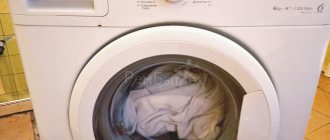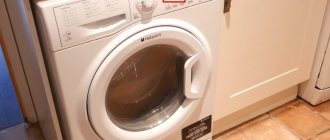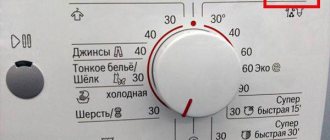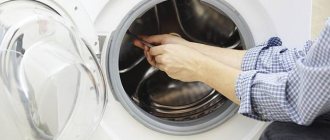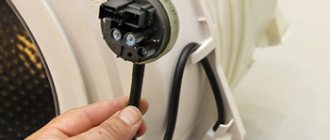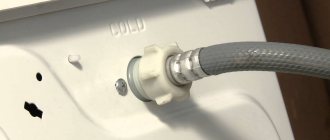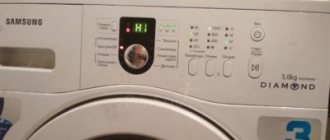We are all accustomed to the fact that modern household appliances will do their job properly and help us around the house, especially with regard to washing, because washing bed linen or any other large item by hand is inconvenient. Therefore, when a washing machine does not wash clothes well, housewives begin to speculate about the reasons behind this.
Naturally, a good technician will determine the exact cause of the breakdown, but not only repairs can correct this situation. Before spending money on calling a technician, watch the washing process of the unit, so some of the reasons for the unsatisfactory performance of the “washing assistant” can be eliminated independently.
The washing machine does not wash well, reasons
If your things and clothes do not become cleaner after washing, but rather become dirtier or worse, become irreparably damaged, then the reason is hidden in the operation of the unit. Naturally, satisfactory results depend on the quality of the powder, bleaches, vanishes and conditioners.
But replacing the detergent does not always correct the situation. There are many reasons why the machine does not wash clothes well, and most often they lie inside the unit, i.e. it is impossible to see them with the naked eye.
Such breakdowns occur at different times, i.e. the performance of the unit either decreases gradually over years of operation, suddenly or immediately after purchase. So, let's look at the main reasons why a washing machine does not wash well and find out whether you can solve this problem yourself.
Drum bearing wear
If the machine is not new, then the bearings may wear out. As a result, the drum begins to spin much weaker and less frequently, and this, in turn, affects the quality of the wash. To check if there is such a problem in your unit, run a standard cycle and pay attention to whether the drum rotates at a sufficient speed. You can even detect this damage visually. To correct the situation, it is necessary to replace the bearings, because they are the ones that ensure the rotation of the drum.
Important! If the bearings are not replaced in time, they will begin to corrode, and the lubricant applied to them will leak into the tank during washing and ruin things.
Detergent
It's no secret that dishwashing detergents, soap or soda are not the number one laundry detergents. We use these substances in order to reduce the pain of heavily soiled clothing by pre-treating the stains with them. That is, it is recommended to wash laundry in a machine together with a good powder intended for automatic washing.
Often, young housewives, due to savings, buy cheap products or stumble upon counterfeits of well-known brands. As a result, the washing machine does not wash well, the laundry remains dirty after the wash cycle or stains of undissolved detergent appear on it.
Water
Surely you know that tap water contains various metal salts that determine its hardness. Because of this, things are often washed unsatisfactorily, since the hardness of the water prevents the powder from foaming. As a result, the housewife remains dissatisfied, changes detergents and may even seek help from a specialist.
If the reason why the washing machine does not wash things well lies in the water, then it is necessary to use various softeners when adding powder. Sometimes it is enough to add ordinary soda to make the water softer. Also, problems with washing can be caused not only by poor washing out of the powder, but also by the appearance of yellow spots that were not there before washing.
This situation occurs rarely, but is still possible. The laundry turns yellow or rust-colored dirt appears if, when the machine was drawing water, the liquid itself was dirty, rusty water began to flow, and the built-in filters did not cope with the task.
Accumulation of dirt and mold debris
Keeping household appliances clean is the main rule for housewives. If the machine stops washing, the reason for this is sometimes due to improper care of the device. Contaminants caused by mold and water scale are often the culprits of both unsatisfactory washing results and the cause of unit breakdown, the repair of which will be expensive.
If you find mold, dark or rusty stains on things, as well as a rotten smell after washing, the problem may be as follows:
- The heating element is covered with scale . Deposits that accumulate on the heating element over time can come off and fall into the drum, contaminating the wash.
- Mold due to accumulated moisture . Microorganisms often appear on the sealing rubber of the unit hatch due to the fact that after using the machine, the door was closed immediately and the moisture did not evaporate.
- There are no filters . Unclean water entering the machine, which was not prevented by special cleaning filters, causes poor quality washing.
If the washing machine does not wash clothes well due to the accumulation of deposits or mold, then treat the infected areas with citric acid and perform a “idle” wash more often (without loading laundry) at high temperatures.
Features of the technology
The reason why a washing machine does not wash well is not always eliminated by changing detergents, softening the water, or even calling a technician. A large assortment of household appliances allows people to buy small-sized machines that not only take up little space, but also use water sparingly.
If your machine does not work as it should, does not wash the laundry and traces of powder remain on it, then the reason lies in the features of the unit itself. If it does not cope with the function assigned to it, then you probably chose the wrong mode or simply loaded the drum with clothes more than 90%. Due to overload, small washing aids often break down and, at best, are not able to rinse the fabric as needed.
Unit failure
If the washing machine begins to do its job poorly, one of the following breakdowns is likely:
- Failure of the heating element - in cold water the unit does not wash away dirt. The heating element needs to be replaced with a working one. The problem may also lie in the control electronics.
- Drive belt deformation. If the belt is stretched, the machine does not rotate the drum. The belt needs to be replaced.
- Bearing wear. If the rotation of the drum is difficult due to wear of the bearings, you should immediately contact a specialist, as the situation will quickly become worse and repairs will be more expensive.
To identify a breakdown, pay attention to how the unit operates. Symptoms include lack of water heating or drum rotation, grinding and clattering noises during operation.
Replacing a drive belt or heating element does not require special knowledge and skills, but dismantling a worn bearing and installing a new one should be entrusted to professionals. Specialists also check and replace the heating element sensor and control triac.
Machine operating mode
If the washing assistant does not remove stains well, then make sure that the program used for washing corresponds to the type of fabric and the recommendations left by the clothing manufacturer on the label. Often the washing machine does not cope with the function assigned to it, because the selected mode is not intended for the clothes that were immersed in the drum.
As you know, synthetic and delicate fabrics such as silk and wool cannot withstand high temperatures, and it is almost impossible to remove stains from cotton without boiling. Thus, if you do not wash in a special mode, then it is pointless to wonder why the washing machine does not wash away stains on clothes well.
If you load a cotton T-shirt with a stubborn, old stain into the drum, but set the washing program to a temperature no higher than 30-40 degrees, then the stain will remain on your item.
Therefore, in order not to overwash your clothes and not damage the machine itself, choose a program that corresponds to the information on the tag, sort the laundry correctly and do not overload the machine.
Various breakdowns
Above we discussed the reasons not related to mechanical damage to the machine. Based on this, powder, mold and water can be easily eliminated on your own. If the washing machine begins to wash poorly due to a breakdown of some unit that rotates the drum during the program or spins, then the result of the device will clearly not correspond to the required one.
Only a specialist can fix such malfunctions, and you can only assume what exactly caused the unsatisfactory operation of the unit.
- The heating element burned out, causing the program to wash in cold water . Anyone knows that it is almost impossible to remove dirt with cold water, let alone a machine that did not wash well due to a failure of the temperature sensor or the heating element itself.
- The bearings have failed, and the drum makes sounds unusual during normal operation during rotation. Due to this problem, the unit is not able to spin things properly and the quality of work will be poor.
- The belt is torn or worn . This is another reason why the unit does not cope with its task, since the drum does not make the required revolutions.
- Is it possible to wash a coat in a washing machine?
- How to wash linen in a washing machine
Malfunction of the level relay (sensor) or its tube
Most often, this breakdown manifests itself as follows: water continues to accumulate after the machine starts operating and does not stop. In order to make sure that the breakdown is in the sensor, you need to remove the sensor tube and examine it for damage and holes. If the tube leaks, it must be replaced with a new one. If the level sensor itself is faulty, then it should be replaced.
You can watch video instructions for replacing the level sensor (relay) below:
We wish you success in self-repair and long life for your household appliances! Have a good day!
readers
lussol:
I have an automatic machine. It worked flawlessly for several years. Today I started doing laundry, and it constantly adds water without stopping. How to independently determine the serviceability of the water level sensor itself before changing it. After all, this may not be the case.
Outwardly it looks strange, the water level in the washing machine does not increase, but you can hear it entering the tank. Often the cause is an incorrect position of the drain hose. Or it happens that even without starting the wash, when the washing machine is turned off, water fills into it and the tank overflows.
Manifestations:
- water is poured in without filling the tank;
- the water level in the tank rises very slowly;
- Water fills the tank and flows out of the washing machine.
Causes:
- Incorrect position of the drain hose;
- Uneven pressure in sewer pipes;
- Blockage in the water supply system;
- Intake valve clogged or malfunctioning;
- Damage to the tube of the water supply level relay (pressostat);
- The pressure switch is faulty.
Repair:
Disconnect from the network. Disconnect the washing machine from the electrical outlet.
Drain hose position. Check the position of the drain hose; it should rise above the ground by at least 60 cm. Many people believe that there is a certain valve on the drain in the washing machine, which supposedly should hold back the water and open at a certain time. But this is not true; draining water from the washing machine is limited only by the height of the drain hose.
drain hose position
It happens that when moving or moving a washing machine, the hose drops, the water begins to flow out by gravity and the tank does not have time to fill up to the required level. To eliminate the problem, it is enough to raise the drain hose to a height of at least 60 cm relative to the lower level of the machine.
Spontaneous drainage. It happens that even with a properly positioned drain hose, water collects and immediately drains away. In this case, the reason is that the pressure in the sewer system is rarefied and water is sucked from the machine into the sewer. To eliminate the problem, it is necessary to install an “anti-drain” valve in the gap in the drain hose, which equalizes the pressure and prevents spontaneous draining of water from the washing machine.
Water supply system. Check the water supply system: the presence of the required water pressure in the system, whether the tap is open, whether water is flowing from the inlet hose, the inlet valve mesh.
The inlet valve is leaking. If water flows into the washing machine even when it is turned off, then the inlet valve is clearly faulty; it is not tightly closed due to clogging or damage to the membrane. In both cases, for stable operation of the machine and for your peace of mind, it is better to replace it. After all, a faulty intake valve can cause severe leakage. Then the washing machine tank will overflow, and water will begin to flow onto the floor, and in the event of your absence, it will flood the apartment and the neighbors below.
Water level switch. If, after starting the wash, the water level rises higher and higher and its flow does not stop, then the most likely reason is a malfunction of the water level switch (pressostat) or damage to its tube.
To check, you need to disconnect the rubber tube of the pressure switch and check its tightness; even with the slightest hole in this tube, the rising water level will not create pressure in the tube and, as a result, the water will not be turned off. If necessary, replace the tube or pressure switch.
